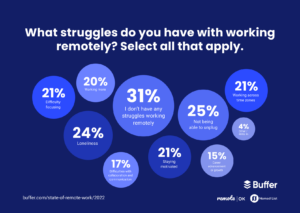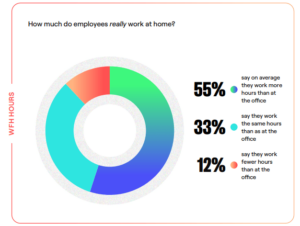According to Owl Labs’s recent State of Remote Work Report, nearly half (42%) of all respondents consider telecommuting the solution to achieving that elusive freedom, flexibility, and work-life balance.
However, a remote work culture isn’t all sunshine and rainbows. Even though it might seem like a dream come true, remote work has plenty of day-to-day challenges.
This article will cover the most common challenges remote employees face and effective solutions to overcome them. Use this as your hands-on guide to overcome these challenges of working remotely and thrive in a remote work environment.
1. Isolation and Loneliness
Working in a remote culture, employees don’t get the chance for face-to-face contact with each other. This physical separation from colleagues can lead to feelings of isolation. The lack of a shared office space also diminishes opportunities for casual conversations and social bonding, exacerbating these feelings. This can be an even bigger problem for remote workers who don’t have family members near them.
As a result, according to Buffer’s State of Remote Work survey, while 22% of respondents say they prefer to work remotely due to its flexibility, 15% struggle with loneliness.

If not addressed, isolation and loneliness can profoundly affect employees’ health and lives.
Here are proactive measures to address isolation and loneliness:
– Try out a coworking space: A coworking space gathers people in an environment where they can, not just work, but also socialize and share experiences with one another. This creates a sense of connection and belonging, mitigating the isolation that can arise from prolonged remote work.
– Encourage virtual work-related meetings: Ask your manager to hold regular video conferencing calls for work-related discussions. This doesn’t just ensure productivity. It also fosters a more intimate and personal connection when compared to relying solely on emails.
– Have virtual social breaks: With the go-signal of your manager, plan frequent virtual breaks with colleagues for social interactions that mimic the casual interactions found in an office environment. These frequent breaks can be informal coffee chats or lunches and virtual team building activities.
Combatting isolation and loneliness will require some time and effort on employees’ and employers’ part. But it will be well worth it for both parties. Loneliness and isolation don’t just affect the health of remote employees like you. It affects workplace productivity as well, with lonely workers five times more likely to miss work due to stress.
2. Communication Issues
The impact of poor communication in a remote workplace setting is evident. Because of the absence of physical face-to-face interactions, messages can get lost in translation. The challenge is intensified when remote employees are working across different time zones.
All these can lead to negative consequences. According to a recent report, 42% of employees say poor communication in business leads to stress, burnout and fatigue. Meanwhile, 68% of respondents say they have wasted time as a result–and therefore, have posted less productivity.

Addressing the communication challenge is crucial not just for remote employees but for management as well.
Here are some effective tips to solve communication challenges when telecommuting:
– Follow your company’s communication guidelines: Your company should have a guide that helps prevent misunderstandings at work. Follow it to the letter, from the times you should send emails to the type of language you should use. If your company doesn’t have those guidelines, tell your manager creating one would help you and your colleagues perform better at work.
– Utilize instant messaging platforms: Take advantage of communication tools such as Slack and Skype typically provided for by management. They’re great since they ensure interactions that emulate physical face-to-face conversations. If you ask a question, you can get your answer then and there.
– Leverage email tools: You can’t really get away from using email to communicate with your colleagues at work. After all, a staggering 62.86% of professionals prefer to use email for business communications. To prevent possible communication issues arising from the use of this channel, you can verify your colleagues’ contact details using an email finder before hitting that Send button You can also use your chosen email platform’s scheduling feature to send messages at a time your colleague is online. This will help ensure they read your messages immediately and respond to them.
Effective communication is key to collaboration. With these communication issues naturally arising in a remote work setup addressed, you can easily complete your tasks and help your team reach its goals.
3. Work-life Balance Struggles
The flexibility of working remotely can be a double-edged sword. While it eliminates commutes and offers schedule freedom, it can also blur the lines between work and personal life.
Workers may find it challenging to set clear boundaries, leading to extended working hours. Distractions at home, such as household chores or family responsibilities, can further complicate efforts to create a balanced routine. No wonder Owl Labs’s survey reported that 55% of WFH employees say they work more hours than at the office on average.

With the majority of WFH employees having the same experience, we can say work-life balance is one of the biggest challenges of working remotely.
Here are proven strategies to overcome this challenge:
– Establish clear working boundaries: Define your specific work hours to colleagues. Also, set boundaries with family members or housemates to minimize interruptions during focused work periods.
– Employ time management tools: Utilize time-tracking tools to schedule tasks. This will help you avoid using your personal time for work purposes.
– Take breaks: Frequent breaks are essential for any worker but especially crucial for those working remotely. The lack of a physical separation between work and personal life can easily lead to burnout if you don’t step away from your screen regularly.
With these practical strategies, you can foster a balanced and sustainable remote work routine that will also ensure your productivity.
4. Technical Issues
As a remote worker, you work with various technology devices. When there are technical challenges, you may have to fix things yourself since it may take time before the IT team can read your message.
Issues with internet connectivity, hardware malfunctions, or software glitches can disrupt workflow and cause productivity setbacks. Inconsistent access to IT support can exacerbate these problems, prolonging downtime and hindering task completion.
That said, here are effective ways to overcome those pesky technical problems:
– Invest in continuous learning and training: Stay informed about the technology you use. Attend training sessions or workshops to enhance your technical skills so you can troubleshoot common issues independently.
– Have a regular maintenance plan: Keep your technologies maintained on a daily basis to prevent potential issues. Regularly update software, run antivirus scans, and address any signs of wear or malfunctions promptly.
– Ask for access to good company IT resources: Work with your managers to ensure access to reliable IT support every time. You can ask for a technical knowledge base you can refer to when something happens and the IT team is not available.
As a final tip, remember, data loss is a remote worker’s nightmare. So, don’t wait for technical issues to occur. Use robust backup solutions like cloud storage or online backup services like Dropbox for crucial files and data from the get-go. If something happens, at least you still have all your important files.
5. Distractions at Home
When working from home, you don’t have coworkers hanging over your shoulders or other disruptions associated with working from an office.
However, you still have more distractions than you can imagine. The siren song of the fridge, the neighbor’s enthusiastic weed whacker, or your friends celebrating their birthdays can be productivity assassins.
Home responsibilities, family activities, and household chores can divert attention from work tasks, impacting productivity as well. The absence of a structured office setting makes establishing a professional and focused work atmosphere challenging.
Here’s how to eliminate those distractions and ace your remote work game:
– Designate a dedicated workspace: If working from home, designate a specific workspace, free from clutter and tempting distractions. This creates a mental boundary between work and personal life, reducing the impact of household distractions.
– Create a daily schedule: Develop a structured daily schedule that includes dedicated work blocks, breaks, and specific household tasks. A well-planned routine assists in managing time effectively, minimizing the impact of distractions on overall productivity.
– Utilize focus techniques: One of the most effective focus techniques is the Pomodoro technique. Divide work into focused intervals with short breaks in between. This method maintains concentration and prevents task overload. You can also follow the 1-3-5 rule, which allows you to focus on getting one big task, three medium tasks, and one small task done in a single day.
For the best results, complement these techniques to address distractions at home with technology to enhance your productivity. Generative AI, for instance, can help you quickly write blog posts or generate responses to customer queries. Explore other generative AI use cases to get the most out of this technology and get more things done in a workday.
In Closing
Remote work is here to stay. However, while it offers incredible benefits, it also presents unique hurdles. The good news is the challenges of working remotely aren’t too great to overcome.
By acknowledging them, embracing effective solutions, and fostering a culture of open communication and collaboration, you will not only survive but thrive in this new era of remote work.









